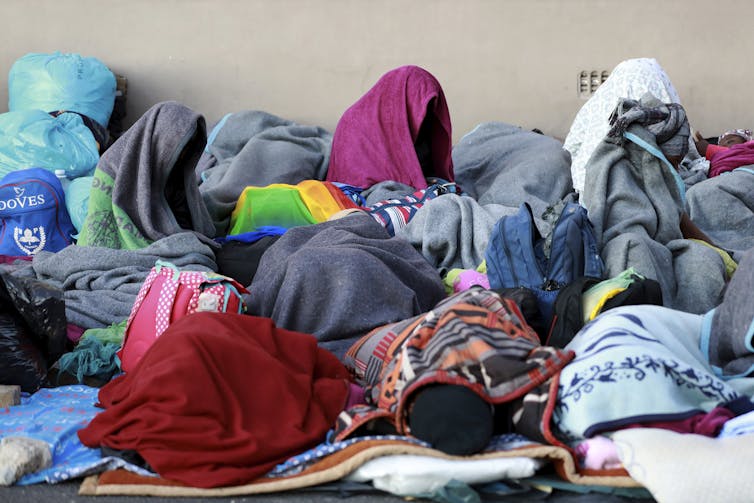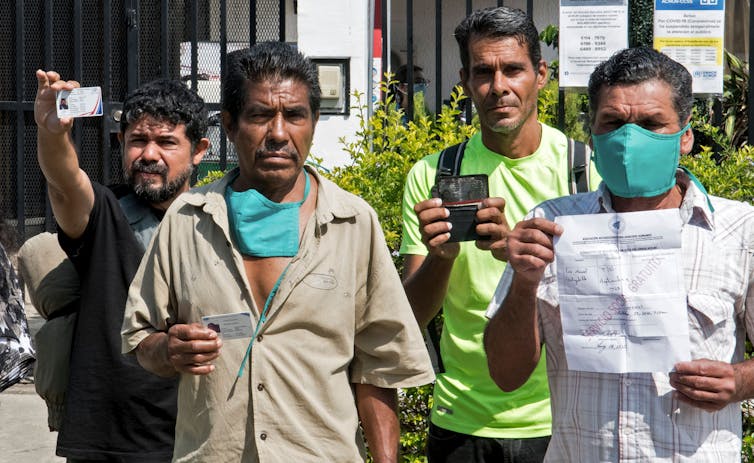Refugees tell stories of problems – and unity – in facing the coronavirus
- Written by Karen Jacobsen, Henry J. Leir Chair in Global Migration, Fletcher School of Law & Diplomacy, Tufts University
Across the globe, refugees are trying to settle into new surroundings and are running into new challenges thanks to the coronavirus pandemic.
But too often news coverage of refugee issues doesn’t include the people’s own voices. We coordinate[1] the Refugees in Towns[2] project, which is a network of refugee researchers and humanitarian workers who we train to conduct research and then write about their experiences in the cities where they live.
We asked members of our network to tell us how the COVID-19 pandemic was affecting their lives. Here are dispatches from South Africa, Serbia, Zimbabwe, Costa Rica, Denmark and Jordan, written by our refugee researchers and aid workers.
Denmark
Denmark hosts 39,000 refugees and asylum seekers[3], from countries such as Syria, Iraq and Somalia. Abdullah, a Syrian refugee in Aarhus, wrote:
The Ministry of Health has published fliers and educational videos in multiple languages to help refugees understand the new rules (ed: about the coronavirus). The Danish Refugee Council used Facebook to help refugee students with their homework by matching them with local volunteers. Refugees took initiatives … through social media groups created to translate information, news and new rules.
Refugee parents with kids in school experience new challenges with remote teaching, and try to use the (refugee council) groups to help. My friend Reem told me about her difficulties communicating with her daughter’s school through the school app because it is in Danish.
The refugees and the Danes say the coronavirus crisis is creating a kind of unity among people. It shows how the world is interconnected and everybody learns lessons about taking care of each other.
In this video from the U.N.‘s High Commission on Refugees, the students of Za’atari refugee camp in Jordan continue their education despite the closure of the 32 schools in the camp to prevent the spread of the coronavirus.Zimbabwe
In recent years, some of the people who fled Zimbabwe during then-President Mugabe’s dictatorship[4] have begun returning. But the economy, power supply and health care system are all in desperate straits[5]. Tash came back to “Zim” 17 years after her family was forced to leave their farm during Mugabe’s expulsions of white farmers[6]. She wrote from Harare:
Zim has been in lockdown now for three weeks and only critical industries like food stores and farming are allowed to operate. The government is applying the rules to both formal and informal sectors, which is a relief. Many people are concerned about our dilapidated health system, but I think we could prevent a major outbreak if people continue to take the lockdown seriously – which they have been doing, amazingly. Social media has reached the rural population.
Perhaps because our economy is so broken, shutting down has not had such a big impact. Our private sector is good at self-regulating and caring for their employees. Many businesses gave hand sanitizer and masks to their workers and some even closed before the lockdown so their staff wouldn’t have to risk travel on public transport. Businesses and money transfers don’t require physical transactions – things continue through WhatsApp. If anything, the shutdown has made life easier, with less pressure on ZESA (Zimbabwe Electrical Supply Company), we have had power all week!
Most people don’t have the means to panic-buy so the shops are still in good stock. People don’t stress about finding fuel (we are only allowed within 5 km radius; the police check and arrest people who go beyond) and many people are walking as they have the time. However, I feel removed living in the “suburbs” with a pantry full of food.
Serbia
Serbia has almost 9,000 refugees[7], mostly from Afghanistan, Syria, Pakistan and Bangladesh, who are seeking to move deeper into Europe but are stuck in Serbia. Our Serbian researcher, Teodora, wrote from Belgrade, with a description of how aid organizations, known as NGOs, stopped working after the pandemic began:
Almost all humanitarian NGOs withdrew from the field, the Commissariat and one NGO in Belgrade are the only ones working. MSF (Doctors Without Borders) have also withdrawn – they were providing showers and laundry for migrants who live outside reception centers. Migrants in reception centers have water and soap, but not gloves and masks (except what they sew themselves). Lots of people live in a same room (up to 10). They are completely isolated and not able to go anywhere. There are often demonstrations and sometimes violent protests organized by migrants in reception centers. They don’t understand that Serbian people are in quarantine too, and the shops are closed. So, they are angry, thinking that they are simply victims of racism (which is not completely untrue).
Canada
Canada has resettled thousands of Syrian refugees[8]. One of them, Noor, reflected on what the pandemic and lockdown is like for refugees living with past trauma and psychosocial problems:
It’s not like the war; the war was easier. When we were in Syria, we knew where the attacks would be, and we could move or hide. Not with a virus … We can’t see it. We don’t know where the danger is. During the war we didn’t isolate (ourselves).
South Africa
South Africa hosts almost 273,000 refugees and asylum seekers[9] from different African countries, including Zimbabwe, Somalia and Eritrea. Barnabas, a Zimbabwean university student living in Makhanda, wrote:
The best decision I made this year was to move out of the university residence. When President Cyril Ramaphosa announced South Africa’s lockdown the university administration ordered those in residence to vacate in less than 24 hours. International students were ordered to leave even though there were hardly any flights and some countries were already under lockdown. There was panicking and anxiety among us, even though we were eventually allowed to stay.
 Refugees sleep on a sidewalk in Cape Town, South Africa, Friday, March 27, 2020, after South Africa went into a nationwide lockdown for 21 days.
AP/Nardus Engelbrecht[10]
Refugees sleep on a sidewalk in Cape Town, South Africa, Friday, March 27, 2020, after South Africa went into a nationwide lockdown for 21 days.
AP/Nardus Engelbrecht[10]
Since the lockdown, I have remained holed up at my place. Videos of soldiers and the police kicking those who have dared to walk on the streets during the lockdown have been circulating on social media. As an immigrant, I would not want to be on the streets.
Many immigrants work as Uber drivers and waiters, but Uber service is barred, and those depending on tips have no income. Most spaza shop (an informal convenience store) operators in the townships are Somalis and Ethiopians. However, when the Minister of Small Business Development announced which shops should remain open, it was only shops owned by South African nationals, and only they would be compensated for losses. That means immigrants will struggle to raise money to rent the premises they occupy in townships.
It’s interesting how unity has emerged among Zimbabweans here. They are usually a divided community, but now they are mobilizing resources using social media groups like 'Zimbabweans in Cape Town’ and helping each other buy food and pay rent.
Costa Rica
Costa Rica officially has 37,000 refugees and asylum seekers[11], but so-called “irregular migrants[12],” many from African countries, fly to a South American country, then travel north and transit Costa Rica en route to the U.S. On March 18, the government closed its borders and began enforcing strict controls. Michelle, an aid worker in San Jose, wrote:
I’m pretty annoyed with border controls and government double talk, it’s obvious that when they close borders many migrants are going to transit through the blind spots. The president has ordered that any migrant resident that leaves the country in the next months will lose [their residence] condition, i.e. permission to be in the country.
 Nicaraguan and Cuban homeless migrants demonstrate outside the U.N. High Commissioner for Refugees office, demanding help amid the new coronavirus pandemic, in San Jose on April 21, 2020.
Getty/Ezequiel Becerra / AFP[13]
Nicaraguan and Cuban homeless migrants demonstrate outside the U.N. High Commissioner for Refugees office, demanding help amid the new coronavirus pandemic, in San Jose on April 21, 2020.
Getty/Ezequiel Becerra / AFP[13]
As of March 22, the migration police have deported 511 migrants across the northern border with Nicaragua. At the southern border with Panama, the government accepted 2,600 African and Haitian migrants and took them to a detention center in the north, because Costa Rican authorities apparently could not contain the flow.
Jordan
Jordan hosts some 745,000 mostly Syrian refugees[14]. This is a high number, but not as high as Lebanon, which hosts some 1.5 million Syrian refugees. More than 80% live outside refugee camps, in Jordan’s towns and cities. Ruby, a Jordanian aid worker in Amman, writes:
Prices of essential items have increased with serious consequences for both refugees and poor Jordanians. The Jordanian government has set price ceilings for essential goods like groceries and announced penalties for noncompliance. Some landlords show understanding and have accepted delaying rents for the current month. Some restaurant owners provide free meals for volunteer youth … Students continue their education through the electronic platforms launched by the Ministry of Education, and through the private TV channel, but some Syrians struggle to pay for internet cards.
[Get facts about coronavirus and the latest research. Sign up for The Conversation’s newsletter.[15]]
References
- ^ coordinate (www.refugeesintowns.org)
- ^ Refugees in Towns (www.refugeesintowns.org)
- ^ 39,000 refugees and asylum seekers (www.unhcr.org)
- ^ President Mugabe’s dictatorship (www.nytimes.com)
- ^ are all in desperate straits (www.npr.org)
- ^ Mugabe’s expulsions of white farmers (qz.com)
- ^ 9,000 refugees (data2.unhcr.org)
- ^ thousands of Syrian refugees (www.pewresearch.org)
- ^ hosts almost 273,000 refugees and asylum seekers (reporting.unhcr.org)
- ^ AP/Nardus Engelbrecht (www.apimages.com)
- ^ Costa Rica officially has 37,000 refugees and asylum seekers (www.unhcr.org)
- ^ irregular migrants (migrationdataportal.org)
- ^ Getty/Ezequiel Becerra / AFP (www.gettyimages.com)
- ^ 745,000 mostly Syrian refugees (www.unhcr.org)
- ^ Sign up for The Conversation’s newsletter. (theconversation.com)
Authors: Karen Jacobsen, Henry J. Leir Chair in Global Migration, Fletcher School of Law & Diplomacy, Tufts University

